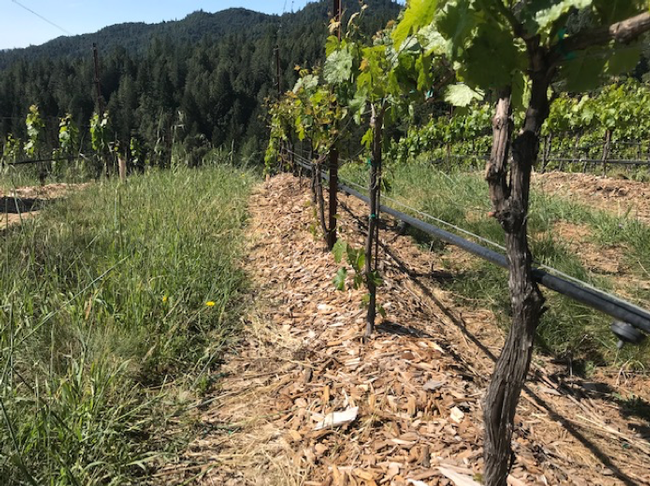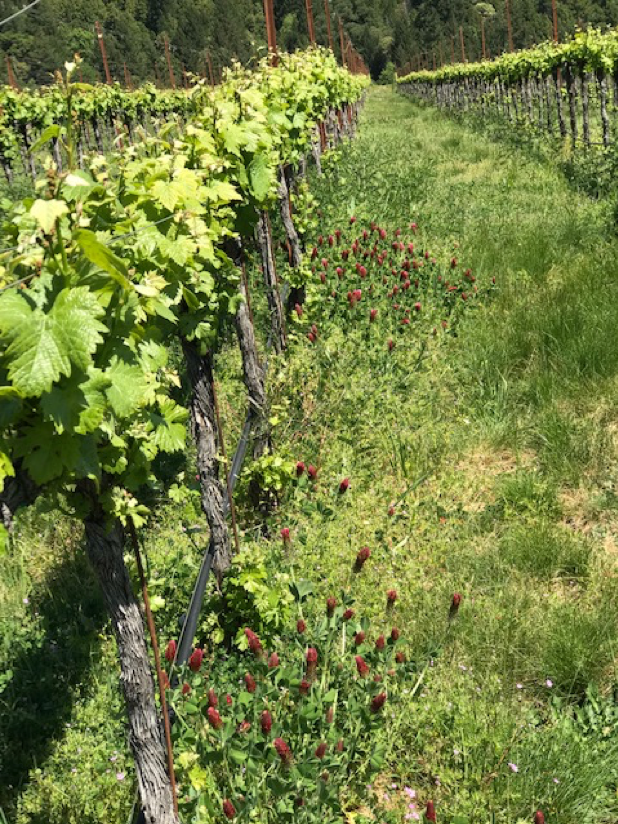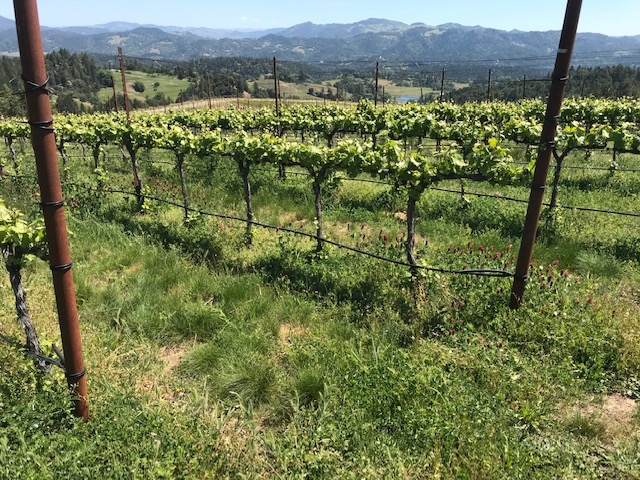
Located in Laytonville, CA, 150 miles North of San Francisco and 12 miles from the Pacific Ocean, sits Alder Springs Vineyard. This remarkable piece of land is home to approximately 140 acres of wine grape vines ranging in cultivars and management practices. To a UC Climate-Smart Ag Specialist, speaking to owner/manager Stuart Bewley and visiting this land is always an informative and inspirational experience. In my work with the CDFA Healthy Soils Program, and later with the North Coast Soil Health Hub, I've had a chance to meet with Stuart on several occasions, and recently got to sit down and record a few of his thoughts on the matter of ecological land stewardship.
A scientist at heart, Stuart took viticulture courses at UC Davis and traveled the world, meeting with other vineyard managers, industry contacts, consultants and experts, to better understand how to produce quality grapes.
“We're in the vineyard business, and in order to attract and keep clients, we have to make great wine. Most of our clients are relatively small, so they have a competitive disadvantage… a smaller company lacks the competitiveness of an army of salespeople being able to twist the arms of distributors, they have to compete on quality. And that quality has to be superior. The wines have to just be extraordinary. And in order for those wines to be extraordinary, their grapes have to be extraordinary. And I believe, in order to keep my clients competitive, I have to grow extraordinary grapes.”-SB
Because of this, Stuart is constantly experimenting with management strategies, tailoring each varietal to their unique management needs. But beyond business, he has a strong pull to make his production more ecologically sustainable for a number of reasons. Increasing Carbon in his soils and reducing herbicide use were the reasons I first received a phone call from Stuart, just a few weeks after joining the UCCE office in Ukiah.
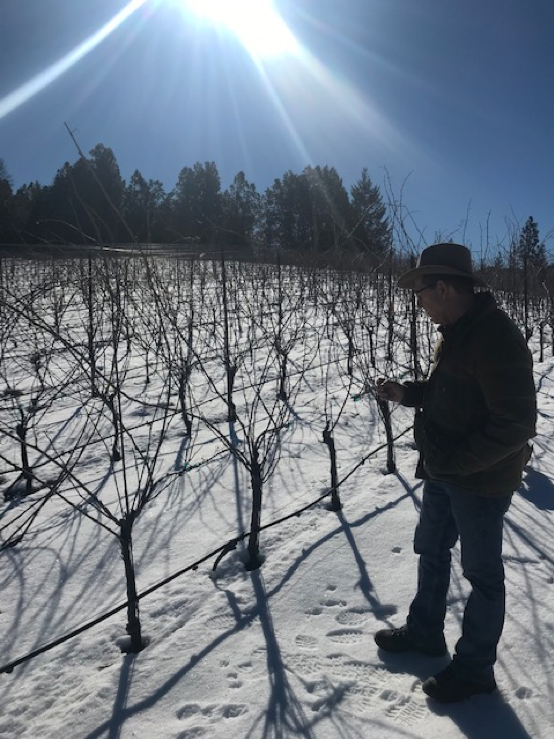
This was early February 2019, and Stuart was interested in applying for a Healthy Soils Program award. His project idea was to apply heavy bands of compost and mulch under his vines to suppress weeds while reducing Nitrogen lockup and erosion, inoculating the soil with microorganisms, and increasing soil Carbon.
“With more and more evidence that Round-Up is carcinogenic, our winery clients are starting to demand we use another method of weed control under-vine. Not wanting to continue to put ourselves, our labor, our customers, or our ecosystems in harm's way, we feel that it is time to change our methods. The only other method used by most Organic or Biodynamic growers is tilling. This method releases carbon into the atmosphere and reduces the organic matter in the soil. We are on hillsides with year-round class 1 streams near our vineyards. (These streams are spawning grounds for Steel Head, King Salmon, and Coho Salmon.) We need a method of under-vine weed control that protects the soil from erosion. Through a small experiment on another parcel, we were able to determine that a one-time application of a 3" mulch layer is enough to suppress weeds and reduce soil erosion for up to 3 years. A thick band of compost under the mulch was shown to add enough available Nitrogen to maintain vine vigor. Together they proved to be an effective practice for suppressing weeds with the added benefit of soil protection from erosion and ultraviolet light. We would also like to measure the effects of these practices on the structure and quality of soil organic matter, the reduction of GHG emissions, and the capacity of soil Carbon sequestration.” -Excerpt from the Alder Springs HSP application (unsubmitted)
Unfortunately, due to the strict implementation requirements of the HSP Incentives Program, we weren't able to submit an application for the last HSP round in March of 2019. Based on their calculations and guidelines of their scientific committee, HSP requires farmers implementing compost and mulch as their project to apply both once a year for three years, instead of the desired one-time application. This requirement was beyond the realms of possibility, because the cost of the project skyrocketed well beyond the max award amount of $75k when tripled, even at the smaller scale of approx. 30 acres. We considered a HSP Demonstration Project, which allows for experimental trials at different application rates, but with the lack of time and resources, the scope of the project unfortunately became bigger than we could chew. Sadly, we had to pull out of the application process at the last moment, with the hopes that we could fine tune a project by the next round in early 2020. The silver lining to this is, upon deciding to go through with the project without CDFA funding, Stuart discovered a large challenge that would have made it nearly impossible to pull off, even with a one-time application of mulch:
“I got too ambitious last time. I should have been simpler and just done a compost application grant. You know what's interesting is I ended up doing a certain amount of this on my own, and I've learned a few things: Putting the mulch on, even though I still like the idea of the program, the amount of time and expense of doing that is astronomical, on any kind of a volume basis. Just because there's so much material you're putting out. Even though the woodchips don't break down very quickly, and they last quite a few years, there's a lot of woodchips out there and the only equipment we can get out there is relatively small equipment. And the number of loads was just massive, and the amount of time it took was incredible. I calculated 1 full time guy, I couldn't even do it in a year if he worked 50 hours a week. I was going, ‘wow I can't put that kind of commitment into this.'”- SB
Pulling off the grandiose scope of work commitment with these grant agreements is one potential pitfall, I've discovered from working on these grants this year. Several of the HSP award winners I've worked with are operating with a sort of shell-shock as they are starting their projects and fully realizing what they signed up for. Scope of work revisions are possible, but with the winter season approaching and the year 1 deadline looming, getting out there sooner rather than later is key. This is advice I will be preaching in the following rounds: go for what you realistically want to do on your land with just a few months' notice. It's better if you consider this opportunity as spending your own time and money instead of getting piles of free money from the government. A small project may be funded more readily than an ambitious project that will need to be revised when it's understood you can't actually pull it off.
As for Stuart, he's got another project in mind for this next round of funding: undervine cover crops. He's already started experimenting on a small scale on another parcel.
“I apply compost and then I put down clover seed and just sort of rake it in. Then it pops out and it only grows about 4-5in tall, which is no problem. And then I bought a Fischer Twister, which is an Italian machine that mows under the vine. I had done about 3-4 acres and it worked fantastically. It eliminates tilling, it eliminates herbicide, it uses compost, and it also sequesters Carbon through the growing plant material, and it totally prevents and eliminates erosion, and it also builds bacteria and fungi (particularly fungi for vineyards) in the soil. Any volunteer weeds that grow taller than clover get mowed out.” -SB
He admitted this experiment does work better on older vines, with no noticeable reduction to vine vigor and without a need to increase irrigation. In contrast, younger vines still require twice as much watering as their roots compete for available soil moisture. But the benefit of reducing erosion on the hillsides makes it a valuable management practice regardless.
“Where I've got grass or cover crop only in the [tractor rows], after 20 years it's higher than the [vine]row itself. The [vine]row is sinking. That's probably the result of erosion or it's just naturally losing Carbon and we're not reapplying Carbon. Whereas on mowing, I probably have to mow 4-5 times a season. So not only do I have plants that are growing and have root mass, but I'm also adding all their cuttings to the same area 5x a year. Over 20 years the tractor rows are building up and the vine rows are sinking. So now the vine rows are becoming a stream bed, and we're seeing even more erosion.” -SB
Stuart intends on applying for the next round of HSP Incentives Program awards for his undervine cover crop experiment, but he's also got something else on his mind that hasn't made it onto the HSP list of eligible management practices: biochar.
“We have massive numbers of acres of forest that are tremendously over-populated with underbrush. So my forest, and everyone else's forests, are tinderboxes waiting to explode on an October afternoon with low humidity and high winds. So instead of sequestering Carbon, we're releasing it into the air in massive forest fires. If you were to take a substantial percent of that Carbon, and chip them up and turn them into biochar, not only would you be able to prevent forest fires, you would be able to sequester it in agricultural soils for a thousand years. Biochar changes the whole structure of the soil. It absorbs a tremendous amount of moisture, and a small piece of biochar can be the home for millions of bacteria and fungi. Because they absorb and hold so much moisture, you can create an environment where soil biology functions properly, and it sequesters moisture for the plants that are growing there. It doesn't hold moisture like clay does, it allows it to pass through slowly. It both holds it and allows it to drain.” –SB
For now, the matter is up for debate. It will not be included in the Healthy Soils Program until enough people ask for it during a public comment period and then they would need to collect enough data on it through Demonstrations before it could become eligible through the Incentives Program. But that won't stop Stuart from doing a few small experiments here and there as he can swing them.
“I don't want to say ‘Oh, I'm not going to play in your sandbox, cause you're not playing the right game.' I'm going to play in the sand box, and at some point I will introduce the right approach, and maybe somebody will say ‘wow that really works.' … I want to participate AND I want to do the right thing.” –SB
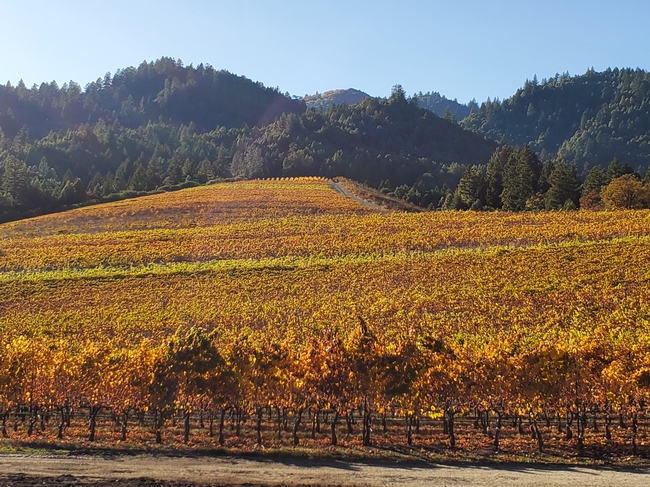
To learn more about Stuart and Alder Springs Vineyard, you can find their website online at https://www.alderspringsvineyard.com/ and follow them on Instagram @alderspringsvineyard.
To learn more about the work of the North Coast Soil Health Hub, particularly their soil health assessments for Northcoast vineyards, their website is http://soilhub.org/.
Climate smart agriculture encompasses management practices that increase soil carbon sequestration, reduce greenhouse gas emissions, improve yields and efficiencies, and promotes climate resilience. The California Department of Food and Agriculture (CDFA) supports three funding opportunities in climate smart agriculture: the Healthy Soils Program, the State Water Efficiency & Enhancement Program, and the Alternative Manure Management Program.
In a collaborative partnership, CDFA and UC Agriculture and Natural Resources have teamed up to support 10 Community Education Specialists throughout the state to provide technical assistance and outreach for the climate smart agriculture programs. To learn more and locate a specialist near you, visit http://ciwr.ucanr.edu/Programs/ClimateSmartAg/.
